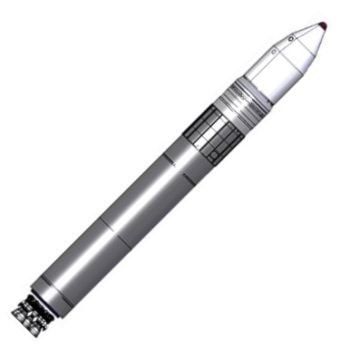Manufacturer SpaceX Height 29 m (95 ft) | Country of origin United States Diameter 3.65 m (12 ft) | |
 | ||
Function Human-rated re-usable orbital launch vehicle Mass 155,000 kg (340,000 lb) | ||
The Falcon 5 was a proposed two-stage-to-orbit partially reusable launch vehicle designed by SpaceX, since canceled in preference of the larger, more powerful Falcon 9.
Contents
Overview
The first stage of Falcon 5 was to be powered by five Merlin engines and the upper stage by one Merlin engine, both burning RP-1 with a liquid oxygen oxidizer. Along with the Falcon 9, it would have been the world's only launch vehicle with all stages designed for reuse.
The Falcon 5 would have been the first American rocket since the Saturn V to have full engine out capability, meaning that with the loss of one engine, it can still meet mission requirements by burning the other four engines longer to achieve the correct orbit. In comparison, the Space Shuttle only had partial engine out capability, meaning it may not be able to achieve proper orbit by burning the remaining engines longer.
Launcher versions
In 2006, SpaceX stated that the Falcon 5 was a Falcon 9 with four engines removed. Since the launchers were being co-developed, work on the Falcon 9 was also applicable to the Falcon 5.
Sources for this table are from Space Launch Report and SpaceX and footnoted here.
Payload capabilities
Related launch vehicle plans
Although an original Falcon 5 was never built, in December 2011 Stratolaunch Systems announced that they planned to develop a four- or five-engine Falcon 9-derivative two-stage liquid-fueled air-launched launch vehicle to be developed by SpaceX. The launch vehicle was planned to be "along the lines of the company's Falcon 4 [sic] or Falcon 5," and was to have been capable of launching a 6,100 kilograms (13,500 lb) payload into low earth orbit.
The air-launched rocket concept was eventually named the Falcon 9 Air, and was being designed to have only four Merlin 1D engines. However, development was halted in late 2012 when SpaceX and Stratolaunch "amicably agreed to end [their] contractual relationship because the [Stratolaunch] launch vehicle design [had] departed significantly from the Falcon derivative vehicle envisioned by SpaceX and does not fit well with [SpaceX's] long-term strategic business model."
